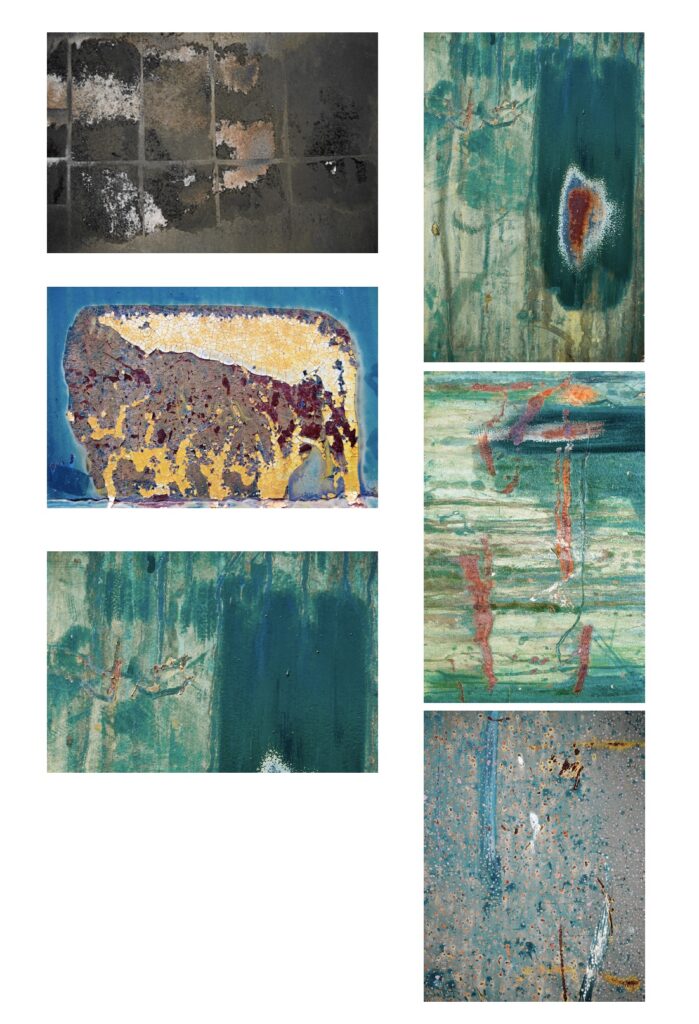Discovering unique patterns on the side of commercial dumpsters, Artist and Photographer Mark Webb, based in Louisville, KY has created an exhibition showcasing industrial art.
What is your background? How did you become an artist? I have a BA in Psychology and English, and an MFA in Creative Writing. I was an IT and Telecommunications Professional for more than 40 years. During my “working” years I always found time to write poetry and take photographs; I found refuge in my creative endeavors. After retiring, I started concentrating on my writing and photography, publishing three books as well as creating a portfolio of photographs in the last five years.
What kind of media do you usually work with? Photography with a digital camera. I learned photography in the 1970s using manual 35mm, medium format, and large format film cameras. The quality of digital now equals film, and I can shoot hundreds or even thousands of photographs without worrying about the cost of film and film processing/enlarging.
What kind of art do you create? For years I only worked with black and white photography, street photography, and landscapes. Recently, I started creating large abstract color photographs.
Why did you decide to work with creating art from dumpsters? Who would think you can extract art from the side of a commercial dumpster! But the art is there—you just have to look closely. When I write poetry, I concentrate on small things to extract larger meaning, in much the same way as Frank O’Hara’s poetry often focuses on the mundane and the routine. I use the same process with my photography. The abstract images I find on a dumpster may only be a few inches wide, but it’s all about taking your time and using your imagination, finding patterns that suggest movement in the shapes, and looking for variations in colors, textures, lines, and weathering. This varies by company and the colors of their dumpsters—red, yellow, blue, green, brown. I’ve even found some cool, turquoise-shaded dumpsters. I call this project Unexpected Art: accidental splatters of paint, forklift gouging, and the randomness of rust found on the ubiquitous bins we see but never notice. As an example, dumpsters are picked up by the large lifts on the trucks. That regular pick-up routine creates scrapes in the paint. It rains and the paint weathers. Over time the scrapes evolve into abstract patterns that I can use in my photographs. Virtually every dumpster has these patterns on the sides created by this emptying/removal process. That’s just one example. There are lots of ways dumpsters “age”. I just drive around town looking behind grocery stores, restaurants, shopping centers, and the like. I’m careful to stay in public areas and not violate anyone’s privacy. I’ve had many employees sent by their managers come out of stores asking me why I’m lying down behind their dumpster. I explain I’m a photographer working on a project with dumpsters, and there is just this coolest pattern and colors on their dumpster. And then I show them the pics on my camera’s display. I’ve never been asked to leave.

Where is your art from dumpsters currently displayed? What kind of reaction have you gotten? Have you received any feedback from the waste/recycling industry? I have a one-person show of my dumpster abstracts opening October 6 at The Mellwood Art Center’s Pigment Gallery in Louisville, KY as part of the 2023 Louisville Photo Biennial. Earlier this year, Wheelhouse Art (Louisville, KY) included eight of my pieces rendered as NFT’s in an exhibition. I also keep my work on display in my studio at Aperture Creative Space in Louisville, KY), which is open by appointment. The reaction to my unexpected art from dumpsters has been phenomenal, with many clients purchasing several pieces for their homes and offices. I’ve started talking to companies in the waste industry about possible purchases of my work to decorate their offices or use as gifts for their clients.
Do you plan to continue to work with the medium? What is next for you? Yes, I certainly intend to continue with this work! I am also a musician, playing drums with jazz combos. I just recently started concentrating on an aesthetic that suggests music. Music is linear; it flows from point-to-point. It rises and falls in timbre, pitch, and intensity. I’m very interested in finding abstract images that embody the perspective of forms that move and interweave in the same way jazz musicians interweave the sounds of their instruments.
For more information, e-mail Mark Webb at [email protected] or find him on Facebook: Facebook.com/markleewebbphotography and Instagram: @markleewebbphotography.
